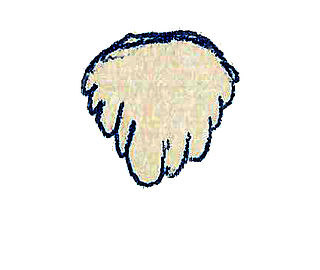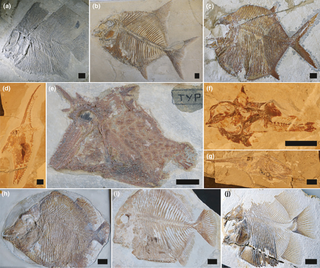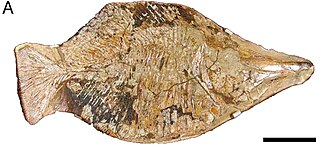
Alocodon is a genus of ornithischian dinosaur known from multiple teeth from the Middle or Late Jurassic Cabaços Formation of Portugal, and also the Forest Marble and Chipping Norton Formations of England. A single species is known, A. kuehnei.

Santanaraptor is a genus of tyrannosauroid theropod dinosaur that lived in South America during the Early Cretaceous, about 112 million years ago.

Pycnodus is an extinct genus of ray-finned fish from the Eocene period. It is wastebasket taxon, although many fossils from Jurassic or Cretaceous are assigned to this genus, only Eocene species, P. apodus is valid. As its name suggests, it is the type genus of Pycnodontiformes.
Anhanguera is a genus of pterodactyloid pterosaur known from the Early Cretaceous Romualdo Formation of Brazil and the Late Cretaceous Kem Kem Group of Morocco. This pterosaur is closely related to Ornithocheirus, but belongs in the family Anhangueridae. The generic name comes from the Tupi words añanga, meaning "spirit protector of the animals" + wera "bygone".

Prionosuchus is an extinct genus of large temnospondyl. A single species P. plummeri, is recognized from the Early Permian. Its fossils have been found in what is now northeastern Brazil.

Pycnodontiformes is an extinct order of primarily marine bony fish. The group first appeared during the Late Triassic and disappeared during the Eocene. The group has been found in rock formations in Africa, Asia, Europe, North and South America. They were small to middle-sized fish, generally with laterally-compressed deep bodies, some with almost circular outlines, adapted for manuverability in reef-like environments, though the group was morphologically diverse. Most, but not all members of the groups had jaws with round and flattened teeth, well adapted to crush food items (durophagy), such as echinoderms, crustaceans and molluscs. Some pyncodontiformes developed piranha like teeth used for eating flesh. Most species inhabited shallow marine reef environments, while a handful of species lived in freshwater or brackish conditions. While rare during the Triassic and Early-Middle Jurassic, Pycnodontiformes became abundant and diverse during the Late Jurassic, exhibiting a high but relatively static diversity during the Early Cretaceous. At the beginning of the Late Cretaceous they reached their apex of morphological and species diversity, after which they began to gradually decline, with a more sudden decline at the end of the Cretaceous due to the collapse of reef ecosystems, finally becoming extinct during the Eocene. They are considered to belong to the Neopterygii, but their relationship to other members of that group is uncertain.
Caririemys is an extinct genus of side-necked turtles, belonging to the Pelomedusoides of the family Euraxemydidae. The type species is C. violetae. A single fossil of an individual was found in the Santana Formation in Brazil, an 80-million-year-old Late Cretaceous deposit that has so far preserved other fossil reptiles such as dinosaurs and crocodilians.
Santanichthys diasii is a species of extinct fish that existed around 115 million years ago during the Albian age. S. diasii is regarded as the basal-most characiform, and is the earliest known member of Otophysi. It appears as a small fish, similar in appearance to a modern-day herring little more than 30 millimeters in length. Its most striking characteristic is the presence of a Weberian apparatus, which makes it the most primitive known member of the order Characiformes, the order in which modern-day tetras are classified. Santanichthys has been unearthed from numerous locations throughout Brazil, in rocks dating to the Cretaceous Period. Its presence in these strata is seen as an indicator for the biogeography and evolution of its order.
Luisiella is an extinct genus of prehistoric bony fish that lived during the Kimmeridgian stage of the Late Jurassic epoch. Fossils of the genus have been found in either the Cañadón Calcáreo Formation or Cañadón Asfalto Formation in Chubut Province, Argentina.

Brannerion is an extinct genus of prehistoric marine bonefish. Fossils of the genus were found in the Romualdo Formation of the Santana Group, Araripe Basin, northeastern Brazil. It is considered a basal member of the Albuliformes.

Brembodus is an extinct marine pycnodontid fish, the type genus of the family Brembodontidae. It contains a single species, B. ridens, known from the Late Triassic Calcare di Zorzino formation of Cene, Italy.

Proscinetes is an extinct genus of prehistoric pycnodontiform ray-finned fish from the Jurassic.
Santanaclupea is an extinct genus of clupeiform fish from the Romualdo Formation of Brazil. It is named after Santana do Cariri, the town that the Santana Formation is named after and Clupea, Latin for small river fish. The type species of the genus is Santanaclupea silvasantosi, which was named in honor of Prof. Rubens de Silva Santos.

Coccodontidae is a family of extinct pycnodontid fish that lived during the lower Cenomanian. The various genera had massive, curved spines.

Pycnodontidae is an extinct family of ray-finned fishes, ranging from the Triassic period until the Eocene.

The Santana Group is a geologic group, formerly included as the middle part of the Araripe Group, in the Araripe Basin of northeastern Brazil. The group comprises the Crato, Ipubi and Romualdo Formations and is dated to the Aptian to Albian stages of the Early Cretaceous. The formations of the group were deposited in a lacustrine to subtidal shallow marine environment in the Araripe rift basin.
The Maria Farinha Formation is a geological formation of the Parnaíba Basin in Pernambuco, northeastern Brazil whose strata date back to the Danian stage of the Paleocene, or Tiupampan in the SALMA classification.

Iemanja is a genus of pycnodontiform fish from the Early Cretaceous, described from Romualdo Member of Santana Group. This genus is known from only one species, I. palma. This fish is named after Yemọja, water spirit in Brazilian mythology. With length up to 60 cm (24 in), it is characterized by long snout that is probably used to feed from crevices of reef habitats.

Thiollierepycnodus is an extinct genus of pycnodontid fish from the Jurassic of France and Germany. The animal was originally assigned to the genus Pycnodus, but it was given its own genus in 2020. Thiollierepycnodus was 25 cm long, with a laterally flat body and comparatively large fins, indicating that it was a reef fish of considerable manoeuvrability. Its durophagous dentition strongly suggests a diet of hard-shelled organisms. It contains a single species, Thiollierepycnodus wagneri.
Njoerdichthys is an extinct genus of pycnodontid fish from the Cretaceous Hesseltal Formation in Germany.














